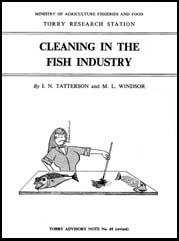Contents Index

Accompanying Notes
Table of Contents
By I. N. TATTERSON and M. L. WINDSOR
MINISTRY OF AGRICULTURE FISHERIES AND FOOD
TORRY RESEARCH STATION
TORRY ADVISORY NOTE No. 45 (revised)
Crown copyright material is reproduced with the permission of the Controller of Her Majesty's Stationery Office.
This electronic document has been scanned using optical character recognition (OCR) software and careful manual recorrection. Even if the quality of digitalisation is high, the FAO declines all responsibility for any discrepancies that may exist between the present document and its original printed version.
Explains the need for cleaning. Differentiates between detergents and sterilisers and their various uses. Summarises the safety precautions necessary when cleaning with respect to both workers and materials. Briefly describes mechanical cleaning equipment available.
The Note was last revised in 1977. Chlorine is one of the simplest, cheapest and most effective disinfectants. If used correctly, it has no tainting and little corrosive effect. Background levels of chlorine at 10 mg/kg can be maintained in the water supply of processing areas during fish processing to maintain a sanitising effect, and increased to 100 to 200 mg/kg at clean-up times. Chlorinators that automatically add chlorine as hypochlorite solution or as gas are easily installed in new or established premises, and the in-plant chlorination system can be simple for small plants or a sophisticated multipoint system for large premises. It can be installed to advantage on trawlers, fish quays and markets, and it is essential for hygienic water cooling of heat sterilised products in the canning industry. It is important to emphasise that the requirements of current legislation on health and safety at work need to be met, and that the minimum requirements for maintaining hygiene in the fish industry are laid down in the public health and food hygiene regulations. In addition to cleaning, scrupulous personal hygiene and control of pests, including rodents, insects and birds, is important at all stages of production, on the fishing vessel or fish farm, at the market, during transportation, at processing plants and in retail and catering premises.
(FAO in partnership with Support unit for International Fisheries and Aquatic Research, SIFAR, 2001).
Introduction
What is cleaning?
Why is cleaning necessary?
What is the difference between detergents and sterilizers?
What types of
cleaning agent are available?
How do detergents work?
Choosing and
using detergents and sterilizers
What precautions
are necessary when cleaning?
Precautions when
cleaning surface materials
Mechanical cleaning equipment
Are there other advantages
in cleaning?
What can be done in the future?
Other sources of advice
Contents Index